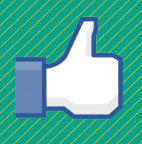 On July 21, Facebook finally surpassed the 500-million member mark. According to some web traffic monitors, Facebook is currently beating Google as the most visited website in the United States. Facebook’s power as a marketing and advertising vehicle can no longer be questioned. Today, Facebook is the web’s largest powerhouse of user-generated reviews and recommendations. Facebook users share more than 25 billion pieces of content a month. This content includes web links, news stories, blog posts, notes, photo albums and more.
On July 21, Facebook finally surpassed the 500-million member mark. According to some web traffic monitors, Facebook is currently beating Google as the most visited website in the United States. Facebook’s power as a marketing and advertising vehicle can no longer be questioned. Today, Facebook is the web’s largest powerhouse of user-generated reviews and recommendations. Facebook users share more than 25 billion pieces of content a month. This content includes web links, news stories, blog posts, notes, photo albums and more.
If only there was a way to take advantage of Facebook’s half a billion share-happy users to promote your website and your products without having to buy ads.
Well, now there is. At the most recent Facebook Developer Conference (F8) in April of 2010, Facebook launched the Like button. This button can be added to just about any website with one line of code. Once added, visitors to your site can click the Like button and automatically share your blog posts or products on their Facebook walls. This share, or Like, will then be seen by all of the friends of the person who clicked the button. This is no small group, considering that the average Facebook user has 130 friends.

The Facebook Like button is already being added to more than 10,000 websites per day. Many of them are already sharing their success rates, such as ABC News’ 190% increase and Sporting News’ 500% increase. Shortly after the Facebook Like button was launched, TypePad (a platform for bloggers) released a feature that enabled all their bloggers to attach a Facebook Like button to the bottom of each of their blog posts. To date, more than 2,400 bloggers have added the feature. TypePad has reported an average of 200 percent growth in referral traffic from Facebook.
So, you have to ask yourself as a marketer: when was the last time that an ad buy increased web traffic by that much?
Oh, and did I mention that the Facebook Like button is free?

Although the button is only a few months old, it is already working its way into web services beyond websites. Email marketing service MailChimp recently released a new version that allows users to add Facebook Like buttons to their email campaigns. At the MobileBeat 2010 Conference held in July, Facebook’s Head of Mobile Products, Eric Tseng, told conference-goers that they could expect to see the Like button go mobile very soon. This is not really a surprise considering that more than 150 million Facebook users connect via mobile devices.
The Like button is the simplest social plugin being offered by Facebook today. At the last Facebook Developer’s Conference, Facebook unveiled an impressive new set of API’s and social plugins that anyone can integrate into their site for free. The plugins range from the simple Like button to threaded commenting and live streaming chat; all hosted by Facebook. This effort by Facebook is good for users because it increases their ability to share with their friends. It is good for your business because it gives you access to easy user recommendations and more traffic. And ultimately, it is good for Facebook, as it makes them a portal to more of the web. These days it seems like Facebook doesn’t want to be the biggest social network on the web—it wants to be the web.
And it is off to a pretty good start. According to the latest statistics, the Like button is clicked about 65 million times a day.


